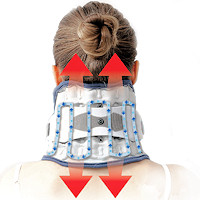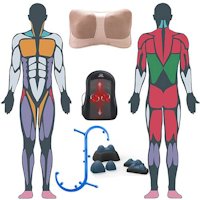Neck Pain Q&A – Will I Get Neck Pain? What Type Of Pain Do I Have? How Long Will It Take To Get Better?
 We go over four main questions and answers in our neck pain Q&A.
We go over four main questions and answers in our neck pain Q&A.
Just behind back pain, depression, and joint pains, neck pain is the 4th leading source of disability, with about 30% of individuals experiencing neck pain in a given year. Often, new episodes of neck pain resolve regardless of treatment, however, almost 50% of those continue to have ongoing pain or frequent flare-ups of neck pain.
Neck pain is often associated with other existing conditions like back pain, headaches, joint pain and depression. Neck pain is seen more frequently in women and in middle aged individuals, although the use of computers and related devices is associated with neck pain at a younger age.
Neck Pain Q&A 1) What Are Risks?
Risk factors are associated with other muscular and joint conditions in general like a sedentary lifestyle, family history or genetics, sleeping disorders, smoking, psychological symptoms such as anxiety and depression, and obesity. Obesity may be a risk factor because of general increase of inflammation, increased biomechanical stress, altered muscle function and related psychosocial factors.
More specific risk factors are whiplash and traumatic brain injuries, and sports such as football, hockey and wrestling. There are indications that working in awkward postures, desk and computer workers as well as some manual laborers have an increased risk for neck pain. Major workplace risk factors are poor job satisfaction and the perception of a bad working environment.
Neck Pain Q&A 2) What Are The Types?
There are many types of neck pain, but factors associated with getting better are duration and initial severity of pain. Typically, acute is pain under 6 weeks duration, and chronic is pain lasting more than 3 months. The time period in between is often called sub-acute. For many treatments, a lower initial pain level and shorter duration is associated with a better treatment results than more long standing pain.
One type is mechanical. Mechanical neck pain is related to pain that originates in the cervical spine or supporting structures, like muscles and ligaments. Mechanical pain includes pain from arthritis of the facet joints, disc related pain, and muscle strain.

Another type pain from a nerve called neuropathic pain, and is due mainly from a disease process or injury to the nerves outside the spinal cord (peripheral neuropathic pain) or more related to the spinal cord (central neuropathic pain). Peripheral types are those like a pinched nerve from a herniated disc or bone spur. This can be from mechanical irritation or chemical response to inflammation of nerve roots, called radiculopathy. The more central types can be related to canal stenosis and often produce symptoms of myelopathy or from the spinal cord. This gets a bit complicated, as there can be mixed types of pain, consisting of both types. Pain from a herniated disc may cause pain from the tear in the disc itself, as well as chemical irritation of the nerve root from inflammation and or direct pressure of the herniation.
Another type is pain referred from organs like the heart or vascular problem, lung or liver.
Neck Pain Q&A 3) How Can I Tell Which Type Of Neck Pain I Have?
Neuropathic pain usually presents with symptoms like, stabbing, shooting, electric like or burning paint, while mechanical pain usually is achy or throbbing.
Neuropathic type pain like a disc herniation, or a condition causing pinched nerve symptoms is usually felt as pain radiating into the shoulder, arm, had or fingers. This can include pain, numbness and tingling. Most commonly involved are symptoms from pinching of the 6th nerve (thumb and index fingers) and 7th nerve root (middle finger) and sometimes parts of the first 4 fingers. This is called a dermatomal pain pattern and is usually distinct in location.
Other neuropathic or mechanical causes that can refer pain into the arms are disc and/or cervical joint problems at the C5 & C6 levels, and neck muscles can cause pain extending into the shoulder, upper back or even arm. These patterns of pain are not as distinct and can vary. Pain form the discs or joints in the upper part of the neck often refer pain into the back of the head.
Mechanical pain usually get worse with activity while neuropathic pain is not as predictable and the worsening is associated with higher levels of pain. When you turn your head to the side of pain and it gets worse, it could indicate nerve pinching or a problem with the joint, where muscle pain is usually associated with pain when turning the head to the opposite side. With arthritis, morning stiffness is usually experienced. Pain when looking up or bending the head back is usually felt with joint problems like the facet joints or narrowing of the spinal cord area, while pain when bending forward is often felt with disc problems.

With a pinched nerve, pain may be relieved with placing the painful side hand on the top of the head, where mechanical neck or shoulder pain usually will not experience any relief or it may be worse when doing this.
Usually, neck pain is better with rest or lying down. Any type of pain that is severe and does not get better with changing positions or rest needs to be evaluated by a doctor.
Neck Pain Q&A 4) What Is The Prognosis?
The prognosis is similar to back pain, where many incidents of pain lasting less than 6 weeks (acute) will get better within a 2 month period, however, almost 50% of those with neck pain will have some level of pain or experience frequent pain after a year.
There are some major factors that stand out to indicate a poor prognosis: symptoms of radiculopathy, psychological problems, older age and gender – women are more prone to neck pain.
Some others factors that are involved in determining chronic or long lasting neck pain are: genetics, headaches, pain related to work factors, back pain and other joint pain issues, poor coping skills, previous neck injury, having poor health, smoking and litigation.
A particular condition associated with the neck and poor prognosis is myelopathy of the cervical spine. This is when the spinal cord is involved from traumatic injury, inflammation, degeneration of the spinal bones (spondylosis) or can indicate a tumor. It typically results in muscle weakness, increased reflexes, muscle spasticity and fasciculations from increased muscle tone, poor control of active motions, usually slow.
So, there are many factors that determine the prognosis in neck pain. But remember, most will get better and resolve in a matter of weeks or months. A high number of individuals will suffer long term neck pain and determining the type is important for the determination of what kind of tests will be done to further diagnose the cause to select a treatment method.
These are some main concerns we often get, so we address them here in our neck pain Q&A.
A 2021 study in the journal Physical Therapy found that people with neck pain have localized increased sensitivity to pain, impaired central pain inhibition, depressive symptoms, tendency to use exaggerated terms to describe pain, to think about it more, and/or to feel more helpless about it, low quality of life, and reduced range of motion during neck rotation.
A 2021 study in the Journal of Electromyography and Kinesiology Found in those with neck pain, increased muscle activity associated with increased postural sway. The authors concluded the increased neck activity in the is likely related to the neck pain disorder rather than postural instability. This is something to consider, especially with dizziness.

 Neck Traction Devices
Neck Traction Devices Cervical Pillows
Cervical Pillows Muscle Therapy Tools
Muscle Therapy Tools